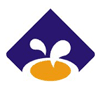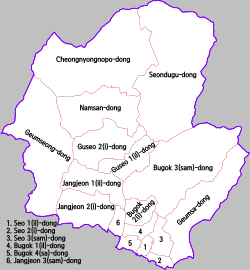
Busan, officially Busan Metropolitan City, is South Korea's second most populous city after Seoul, with a population of over 3.3 million inhabitants as of 2024. Formerly romanized as Pusan, it is the economic, cultural and educational center of southeastern South Korea, with its port being South Korea's busiest and the sixth-busiest in the world. The surrounding "Southeastern Maritime Industrial Region" is South Korea's largest industrial area. The large volumes of port traffic and urban population in excess of 1 million make Busan a Large-Port metropolis using the Southampton System of Port-City classification. As of 2019, Busan Port is the primary port in Korea and the world's sixth-largest container port.

Busan Metro Line 1 is the north-south route of the Busan Metro. It is 40.4 kilometres (25.1 mi) long with 40 stations, and is considered the second longest line of the Busan Metro system, just behind Line 2. But with Line 1 going to regions such as Jagalchi Station, Busan Station, Seomyeon Station, Dongnae Station, and Nopo Station, it is deemed the most popular line of all of the Busan Metro system. Line 1 uses 8-car trains. The line color is orange. Its station signs are circular with a white face and orange frame, boasting the name of the station in Korean in big Hangul letters with the smaller English name below it with the station number in orange beside it and the Hanja name at the bottom of their face in similar-sized font. Unlike in the other stations, Line 1's station signs typically lack arms sprouting from their sides, even on the outer walls; instead, the neighboring stations are printed on a black strip that runs across the outer wall; some exceptions exist as in Seomyeon station, where the signs use the designs used for Lines 3 and 4, albeit with an orange frame.

Haeundae District is a district (gu) of Busan, South Korea.

Dongnae District is a gu (district) in central Busan, South Korea.
Myeongjang is a dong in Dongnae-gu, Busan, South Korea. It is divided into two administrative dong, Myeongjang 1-dong and Myeongjang 2-dong. The total area is 1.78 km2, with a population of 39,656. It borders Geumjeong-gu on the north. The old site of the Dongnae eupseong site is located in Myeongjang-dong.
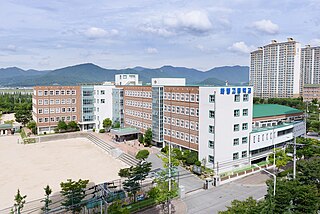
Buk District is a gu, or district, in north central Busan, South Korea. Buk-gu covers a surface of 38.30 km2 is home to about 335,000 people. It attained the status of gu in 1978.

Yeonje District is a gu in central Busan, South Korea. It has an area of 12.08 km2, and a population of about 220,000. Yeonje-gu was created in March 1995 following its separation from Dongnae-gu. Its name was formed by taking the first and last syllables of the names of its only 2 legal dong; Yeonsan-Dong and Geoje-Dong. Busan City Hall is located in Yeonje-gu.
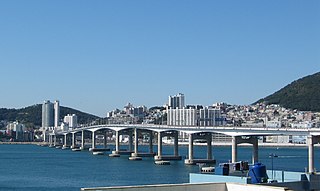
Seo District is a gu, or district, in south-west central Busan, South Korea.
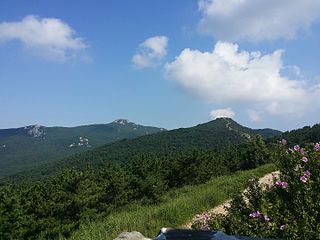
Geumjeongsan is a mountain in Busan, South Korea. Its highest peak, Godangbong, stands at 801.5 meters.

Jangjeon is a dong, or precinct, in Geumjeong-gu, Busan, South Korea. A heavily populated district, it is located between the slopes of Geumjeongsan and the valley of the Oncheoncheon. It is bounded to the south by Oncheon-dong in Dongnae-gu and to the north by Guseo-dong. Due to its large population, Jangjeon-dong is divided into three "administrative dong," Jangjeon 1, 2, and 3-dong.
Geumjeong can refer to the following locations in South Korea:
Keumjeong High School, located in Busan, is a high school in South Korea. It was founded in 1986 and chosen as Autonomic Public School. It has a Taegwondo class and its Taegwondo team has won many prizes. This school is supported by the country because it is an Autonomic Public School which is allowed to arrange curricula to increase students' achievements. It was also chosen as a School of Promoting Education.

Nopo Station is a station of Busan Metro Line 1 located in Nopo-dong, Geumjeong District, Busan, South Korea. The subname in parentheses is Central Bus Terminal.

Dongnae station (Korean: 동래역) is a railway station of the Donghae Line in Nangmin-dong, Dongnae District, Busan, South Korea. The station is unrelated to the Dongnae Station of Busan Metro.

Geumseong is a dong (neighborhood) in Geumjeong District, Busan, South Korea. A lightly populated district, it is situated entirely within the mountain range of Geumjeongsan. It is bounded to the west by Hwamyeong-dong and Geumgok-dong in Buk District, to the northwest by Dong-myeon of Yangsan City, to the east by Cheongnyong-dong, Namsan-dong, Guseo-dong, and Jangjeon-dong of Geumjeong District, and to the south by Oncheon-dong in Dongnae District. The northernmost point in Geumseong-dong is at Godang-bong, the highest peak in Geumjeongsan.

Bugok is a dong (neighborhood) in Geumjeong District, Busan, South Korea.
Dongnae Girls' High School is a private girls high school located in Bugok-3-dong, Geumjeong-gu, Busan, South Korea.
Allak is a dong in Dongnae District, Busan, South Korea. It is divided into two administrative dong, Allak 1-dong and Allak 2-dong. The total area is 2.31 km2, with a population of 18,560. It borders Geumjeong District on the north.
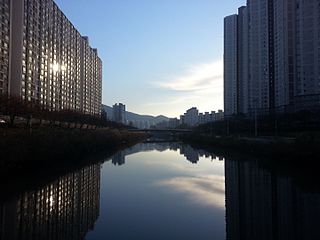
Oncheon-cheon is a tributary of the Suyeong River in Busan, South Korea. It was previously known as the Seocheon or Dongnaecheon. The source of the river is on Geumjeongsan. It then flows through the built-up area of Busan, passing between Allak-dong and Yeonsan-dong along the way.
Yangsan Metro is an under construction rubber-tyred metro line connecting Nopo station in Nopo-dong, Geumjeong District, Busan and Bukjeong station in Bukjeong-dong, Yangsan, South Gyeongsang Province, South Korea. Originally, it was promoted as the Nopo-Bukjeong line.




